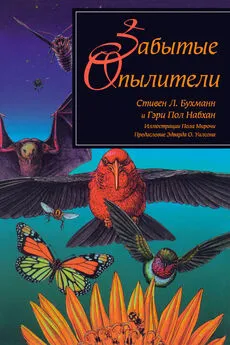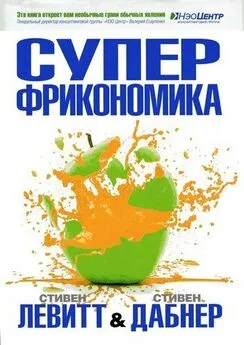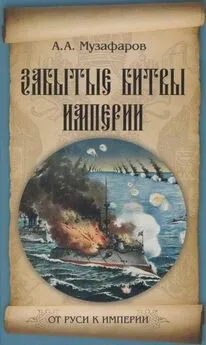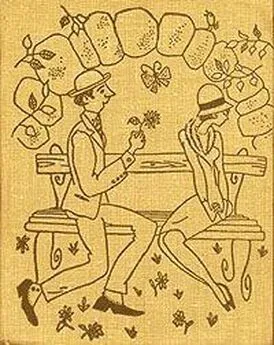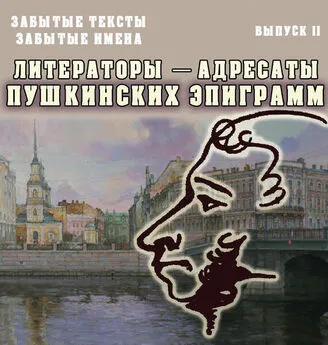Стивен Бухманн - Забытые опылители
- Название:Забытые опылители
- Автор:
- Жанр:
- Издательство:Island Press
- Год:1997
- Город:Washington D. C.
- ISBN:9781597269087
- Рейтинг:
- Избранное:Добавить в избранное
-
Отзывы:
-
Ваша оценка:
Стивен Бухманн - Забытые опылители краткое содержание
Один из авторов книги, Стивен Бухманн, является одним из ведущих мировых специалистов в области опыления и знатоком медоносных пчёл. Второй автор, Гэри Пол Набхан — специалист по этноботанике, эколог, автор множества книг о культуре земледелия и сельскохозяйственных продуктах.
Забытые опылители - читать онлайн бесплатно полную версию (весь текст целиком)
Интервал:
Закладка:
Feinsinger, P., J. A. Wolfe, and L. A. Swarm. 1982. “Island ecology: reduced hummingbird diversity and the pollination biology of plants, Trinidad and Tobago, West Indies.” Ecology 63(2):494–506.
Feinsinger, P., J. H. Beach, Y. Linhart, W. H. Rusby, and K. G. Murray. 1987. “Disturbance, pollinator predictability, and pollination success among Costa Rican cloud forest plants.” Ecology 68(5):1294–1305.
Fiedler, P. 1993. “Habitat fragmentation and its demographic consequences: overview and consequences.” In O. T. Sandlund and P. J. Schel, eds., Proceedings of the Norway/UNEP Expert Conference on Biodiversity. Trondheim: Norwegian Ministry of the Environment.
Fleming, T. H. 1993. “Plant-visiting bats.” American Scientist 81:461–468.
Fleming, T. H., R. A. Nuñez, and L. da Silviera Lobo Sternberg. 1993. “Seasonal changes in the diets of migrant and non-migrant nectarivorous bats as revealed by carbon stable isotope analysis.” Oecologia 94:72–75.
Ford, H. A., D. C. Paton, and N. Forde. 1979. “Birds as pollinators of Australian plants.” New Zealand Journal of Botany 17:509–519.
Free, J. B. 1993. Insect Pollination of Crops. 2nd ed. London: Academic Press.
Fritz, A.-L., and L. A. Nilsson. 1994. “How pollinator-mediated mating varies with population size in plants.” Oecologia 100:451–462.
Ginsberg, H. S. 1983. “Foraging ecology of bees in an old field.” Ecology 54:165–175.
Grant, V. 1994. “Historical development of ornithophily in the western North American flora.” Proceedings of the National Academy of Sciences, USA 91:10407—10411.
Grant, V., and K. A. Grant. 1983. “Behavior of hawkmoths on flowers of Datura metaloides.” Botanical Gazette 144:280–284.
Griffin, B. L. 1993. The Orchard Mason Bee. Bellingham, Wash.: Knox Cellars Publishing.
Griswold, T. 1993. “New species of Perdita (Pygoperdita) Timberlake of the P. californica species group (Hymenoptera: Andrenidae).” Pan-Pacific Entomologist 69:183–189.
Hafernik, Jr., J. E. 1992. “Threats to invertebrate biodiversity: implications for conservation strategies.” In P. L. Feidler and S. K. Jain, eds., Conservation Biology. London: Chapman & Hall.
Hagler, J. R., and S. L. Buchmann. 1993. “Honey bee (Hymenoptera: Apidae) foraging responses to phenolic-rich nectars.” Journal of the Kansas Entomological Society 66(2):223–230.
Hanscom, T., and W. Toone. 1995. “Economic independence and conservation in the tropics.” Wings 18:3–5.
Heinrich, B. 1975. “Energetics of pollination.” Annual Review of Ecology and Systematics 6:139–170.
——. 1979. Bumblebee Economics. Cambridge: Harvard University Press.
Hendrix, S. D. 1994. “Effects of population size on fertilization, seed production, and seed predation in two prairie legumes.” North American Prairie Conference Proceedings 13:115–119.
Hendrix, S. D., R. W. Cruden, and B. M. Molano-Flores. 1993. Effects of Landscape Fragmentation on the Reproductive Biology of Phlox pilosa. Ecological Society of America Abstract 273. Washington, D.C.: ESA.
Hennesssey, M. K., H. N. Higg, and D. H. Habeck. 1992. “Mosquito (Diptera: Culicidae) adulticide spray drift into wildlife refuges of the Florida Keys.” Environmental Entomology 21:714–721.
Hilty, S. 1994. Birds of Tropical America. Shelburne, Vt.: Chapters.
Howell, D. J. 1974. “Pollinating bats and plant communities.” National Geographic Society Research Reports 1373:311–328.
Hughes, N. F. 1976. Paleobiology of Angiosperm Origins. New York: Cambridge University Press.
Hurd, Jr., P. D., and E. G. Linsley. 1964. “The squash and gourd bees — genera Peponapis Robertson and Xenoglossa Smith — inhabiting America north of Mexico (Hymenoptera: Apoidea).” Hilgardia 35(15):375–476.
Hurd, Jr., P. D., E. G. Linsley, and T. W. Whitaker. 1971. “Squash and gourd bees (Peponapsis, Xenoglossa) and the origin of cultivated Cucurbita.” Evolution 25:218–234.
Janson, C. H., J. Terborgh, and L. H. Emmons. 1981. “Non-flying mammals as pollinating agents in the Amazonian forest.” Biotropica 13:1–6.
Janzen, D. H. 1974. “The de-flowering of Central America.” Natural History 83:49.
Jennersten, O. 1988. “Pollination of Dianthus deltoides (Caryophyllaceae): effects of habitat fragmentation on visitation and seed set.” Conservation Biology 2:359–366.
Jennersten, O., J. Loman, A. P. Muller, J. Robertson, and B. Widen. 1992. “Conservation biology in agricultural habitats.” In J. Harrison, ed., Ecological Perspectives of Nature Conservation. London: Elsevier.
Johansen, C. A. 1969. “Bee forage preserves.” American Bee Journal 109:96–97.
——. 1977. “Pesticides and pollination.” Annual Review of Entomology 22:177–192.
Johansen, C. A., and D. F. Mayer. 1990. Pollinator Protection: A Bee and Pesticide Handbook. Cheshire, Conn.: Wicwas Press.
Kevan, P. G. 1974. “Bees, blueberries, birds and budworm.” Osprey: Newfoundland Natural History Society Newsletter 5(3):54–62.
——. 1975. “Pollination and environmental conservation.” Environmental Conservation 2(4):293–298.
——. 1977. “Blueberry crops in Nova Scotia and New Brunswick — pesticides and crop reductions.” Canadian Journal of Agricultural Economics 25(1):64.
——. 1994. Ecologica Evodutiva de la Polinización. Mexico City: UNAM Instituto de Biologia.
——. 1994. “Honey hunting and gathering: a Malaysian tropical forest expedition for the adventurous tourist.” American Bee Journal 134:41–42.
Kevan, P. G., E. A. Clark, and V. G. Thomas. 1990. “Insect pollinators and sustainable agriculture.” American Journal of Alternative Agriculture 5(1):13–22.
Klinger, T., D. R. Elam, and N. C. Ellstrand. 1991. “Radish as a model system for the study of engineered gene escape rates via crop-weed mating.” Conservation Biology 5(4):531–535.
Kohn, J. R. 1988. “Why be female?” Nature 335:431–433.
Koopowitz, H. 1992. “A stochastic model for the extinction of tropical orchids.” Selbyana 13:115–122.
Koopowitz, H., A. Thornhill, and M. Andersen. 1993. “Species distribution profiles of the neotropical orchids Masdevallia and Dracula (Pleurothallid-inae, Orchidaceae): implications for conservation.” Biodiversity and Conservation 2:681–690.
——. 1994. “A general stochastic model for the prediction of biodiversity losses based on habitat conversion.” Conservation Biology 8(2):425–438.
Koopowitz, H., M. Andersen, A. Thornhill, H. Nguyen, and A. Pham. 1993. “Comparison of distributions of terrestrial and epiphytic African orchids: implications for conservation.” In A. Pridgeon, ed., Proceedings of the Fourteenth World Orchid Conference. Edinburgh: HMSO.
Kress, J. W., and J. B. Beach. 1994. “Flowering plant reproductive systems.” In L. A. McDade, K. S. Bawa, H. A. Hespenheide, and G. Hartshorn, eds., La Selva: Ecology and Natural History of a Neotropical Rain Forest. Chicago: University of Chicago Press.
Kress, J. W., G. E. Schatz, M. Andrianifahanana, and H. S. Morland. 1994. “Pollination of Ravenala madagascarensis (Sterlitziaceae) by lemurs in Madagascar: evidence for an archaic coevolutionary system?” American Journal of Botany 81(5):542–551.
LaMont, B. B., P.G.L. Klinkhamer, and E.T.F. Witkowski. 1993. “Population fragmentation may reduce fertility to zero in Banksia goodii — a demonstration of the Allee effect.” Oecologia 94:446–450.
LaSalle, J., and I. D. Gauld (eds.). 1993. Hymenoptera and Biodiversity. Wallingford, England: CAB International.
Lesica, P. 1993. “Loss of fitness resulting from pollinator exclusion in Silene spaldingii (Caryophyllaceae).” Madroño 40(4):193–201.
Linhart, Y. B., and P. Feinsinger. 1980. “Plant — hummingbird interactions: effects of island size and degree of specialization on pollination.” Journal of Ecology 68:745–760.
Linsley, E. G. 1966. “Pollinating insects of the Galapagos Islands.” In R. I. Bowman, ed., The Galapagos. Berkeley: University of California Press.
Lord, J. M. 1991. “Pollination and seed dispersal in Freycinetia baueriana, a dioecious liana that has lost its pollinator.” New Zealand Journal of Botany 29:83–86.
Lugo, A. 1988. “Estimating reductions in the diversity of tropical forest species.” In E. O. Wilson, ed., Biodiversity. Washington, D.C.: National Academy Press.
MacGregor, S. E. 1976.Insect Pollination of Cultivated Crop Plants. USDA Agriculture Handbook 496. Washington, D.C.: USDA.
Matheson, A., S. L. Buchmann, C. O’ Toole, P. Westrich, and 1. H. Williams (eds.) 1996. The Conservation of Bees. Academic Press, London: In press.
May, R. M., and A. M. Lyles. 1987. “Living Latin binomials.” Nature 326:642–644.
McKey, D. 1989. “Population biology of figs: applications for conservation.” Experientia 45:661–673.
Medellin-Morales, S., and M. M. Cruz-Bojorquez. 1992. Xunan Kab: Una experencia etnoecologica y de transferencia de tecnologia tradicionál en una comunidad Maya de Yucatan. Proyecto. Sostenibilidad Maya, University of California — Riverside.
Medellin-Morales, S., E. Campos-Lopez, E. Campos-Nanez, J. Gonzalez-Acereto, and V. Camara-Gonzalez. 1991. Meliponicultura Maya: Perspectivas Para Su Sostenibilidad. Proyecto Sostenibilidad Maya, University of California — Riverside.
Meeuse, B., and S. Morris. 1984. The Sex Life of Flowers. New York: Facts on File.
Menges, E. S. 1991. “Seed germination percentage increases with population size in a fragmented prairie species.” Conservation Biology 5:158–164.
Merrick, L. C., and G. P. Nabhan. 1985. “Natural hybridization of wild Cucurbita sororia group and domesticated Cucurbita mixta in southern Sonora.” Cucurbit Genetic Cooperative Newsletter 7:73–75.
Michener, C. D. 1974. The Social Behavior of Bees. Cambridge: Belknap Press/Harvard University Press.
Michener, C. D., R. J. McGinley, and B. N. Danforth. 1994. The Bee Genera of North and Central America (Hymenoptera: Apoidea). Washington, D.C.: Smithsonian Institution Press.
Mills, S. 1995. In Service of the Wild: Restoring and Reinhabiting Damaged Land. Boston: Beacon Press.
Mittermeier, R. A., I. Tattersall, W. R. Konstant, D. M. Meyers, and R. B. Mast. 1994. Lemur of Madagascar. Washington, D.C.: Conservation International.
Nabhan, G. P. 1973. “A characterization of Galapagos mangrove communities in relation to coastal geomorphological evolution.” Unpublished honors thesis, Prescott College, Arizona.
——. 1984. “Evidence of gene flow between cultivated Cucurbita mixta and a field edge population of wild Cucurbita in Onavas, Sonora.” Cucurbit Genetics Cooperative Newsletter 7:76–77.
——. 1989. Enduring Seeds: Native American Agriculture and Wild Plant Conservation. San Francisco: North Point Press.
——. 1995. “The dangers of reductionism in biodiversity conservation.” Conservation Biology 9(3):479–481.
Nabhan, G. P., and S. Buchmann. 1995. “Chemically-induced habitat fragmentation and disrupted plant/pollinator relationships.” Comments in Toxicology. In press.
Nabhan, G. P., and T. Fleming. 1993. “The conservation of mutualisms.” Conservation Biology 7(3):457–459.
Nabhan, G. P., and H. Suzan. 1994. “Boundary effects on endangered cacti and their nurse plants in and near a Sonoran Desert biosphere reserve.” In G. P. Nabhan and J. L. Carr, eds., Ironwood: An Ecological and Cultural Keystone of the Sonoran Desert. Conservation International Occasional Papers in Conservation Biology I. Washington, D.C., Conservation International.
National Association of State Departments of Agriculture. 1991. Honey Bee Pests — A Threat to the Vitality of U.S. Agriculture: A National Strategy. Washington, D.C.: NASDA.
Читать дальшеИнтервал:
Закладка:
